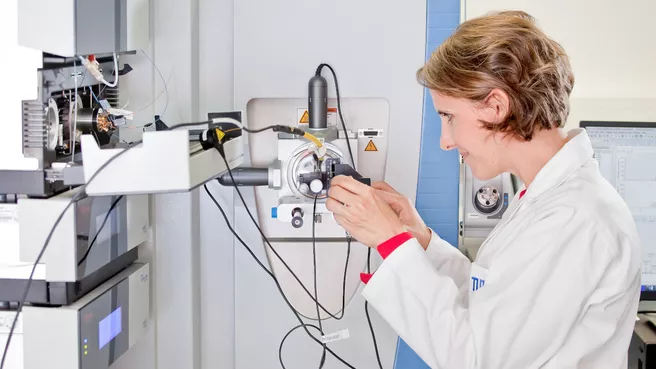In this process, the researchers discovered something unexpected: Most bacterial mRNAs have very similar translational efficiencies, but the promoter strengths of the genes differ greatly. The researchers were able to demonstrate close coordination between transcriptional strength and ribosomal activity and found that in bacteria, protein concentration is primarily determined by transcription.
Bacterial adaptation to changing growth conditions
In a continuing project, the adaptation of Escherichia coli during the transition from an amino acid-rich to a minimal medium was analyzed. In an amino acid-rich medium, Escherichia coli can take up all needed amino acids directly from the medium and therefore put all its energy into the production of proteins that are responsible for the production of more proteins. These so-called ribosomal proteins are essential for maximally fast growth. In the transition to a minimal medium without amino acids, the bacterium must rearrange its resources and generate new proteins that will produce the missing amino acids (the enzymes of the amino acid biosynthesis pathways). Since the total number of proteins in a bacterial cell is limited (maximum protein density), the bacterium must find an optimal balance between ribosomal protein biosynthesis and amino acid biosynthesis.
Mathematical model can simulate bacterial growth
The absolute proteome data collected in this project allowed the researchers to create a kinetic model describing the production of the enzymes of the amino acid biosynthetic pathways. This mathematical model showed a surprisingly clear correlation between the onset of enzyme production and the respective "enzyme reserve" in Escherichia coli before medium exchange. The researchers were able to use their model to predict how Escherichia coli changes its gene expression as needed, depending on the initial growth condition and the new situation to which it must adapt.
"The knowledge gained in both research projects described is crucial for a better understanding ofgene regulation in bacterial cells and to simulate bacterial growth using mathematical models," Dr. Ludwig explains the significance of the results. The novel findings will help to better predict bacterial behavior in the future.
Publications:
- Journal Science: https://www.science.org/doi/10.1126/science.abk2066
- Journal Nature Microbiology: https://www.nature.com/articles/s41564-022-01310-w
Scientific contact:
Dr. Christina Ludwig
Bavarian Center for Biomolecular Mass Spectrometry (BayBioMS)
Center Leader Proteomics
tina.ludwig(at)tum.de
Editing:
Susanne Neumann
TUM School of Life Sciences
Press and Public Relations
